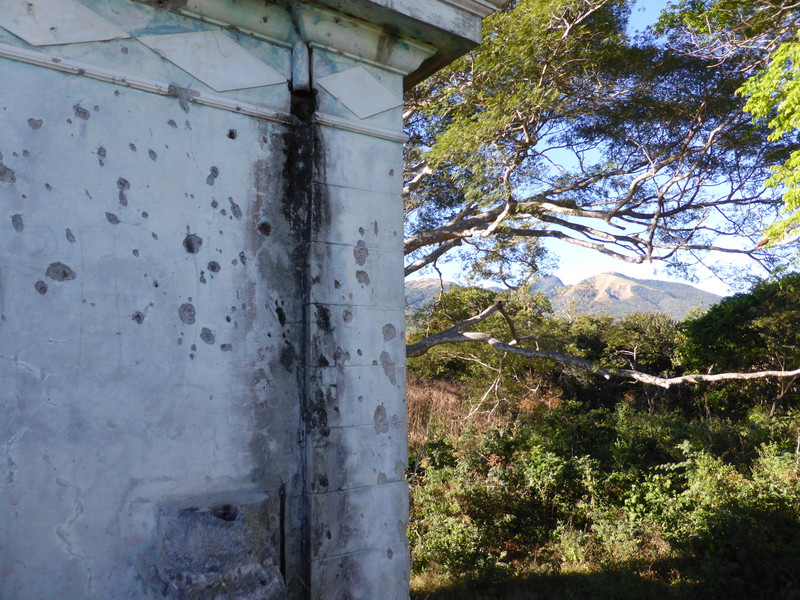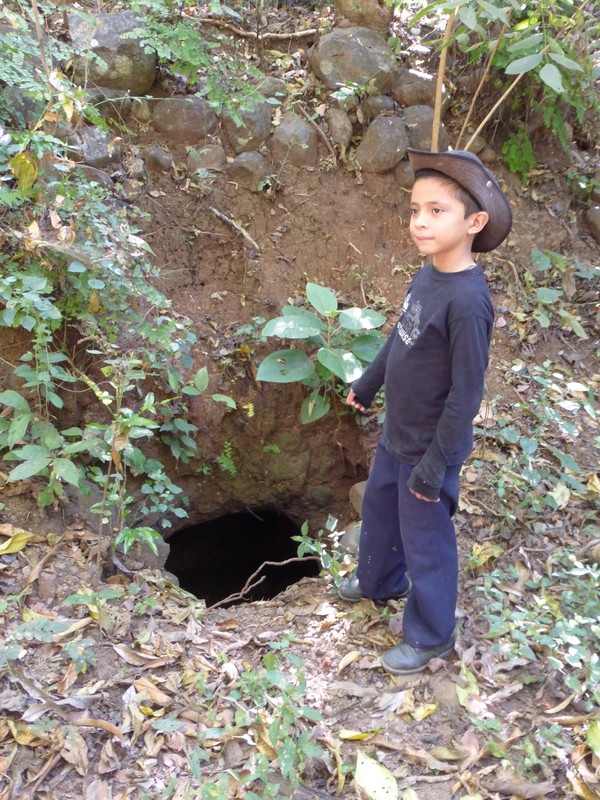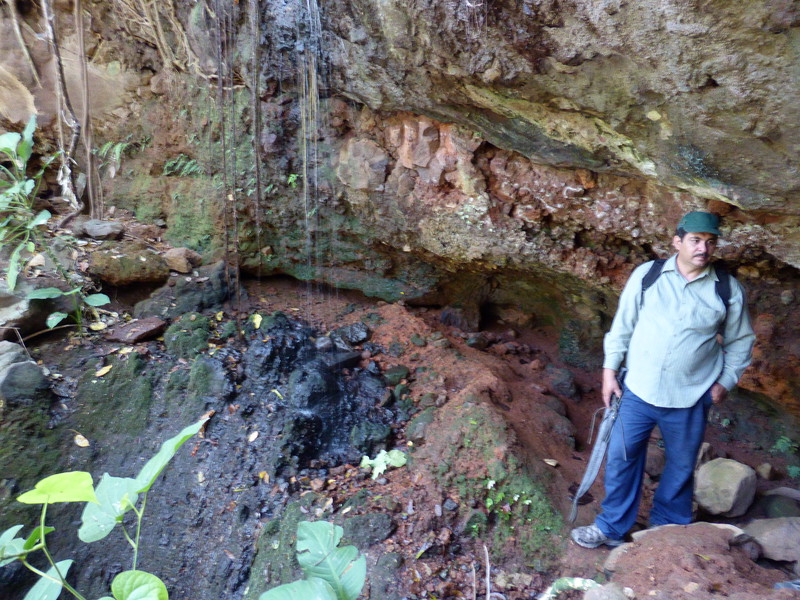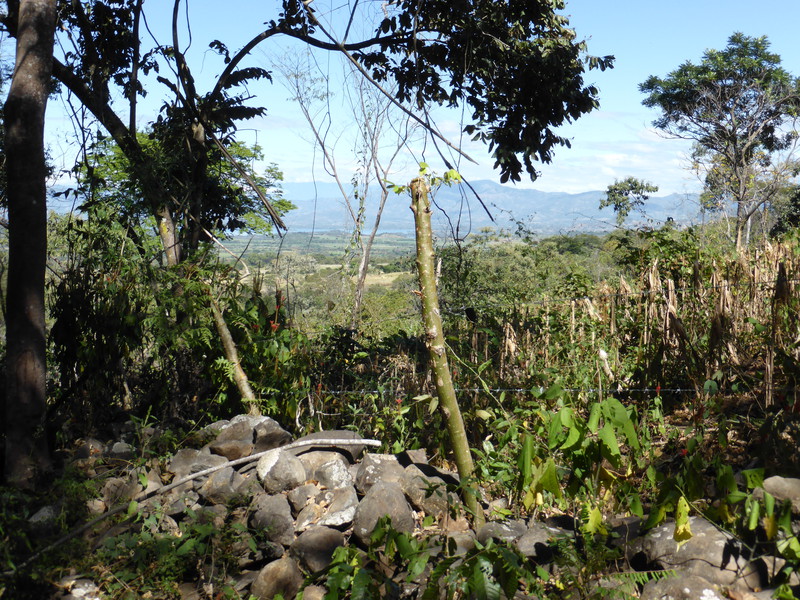
We really enjoyed teaming up with Pamela and Matteo for our visit to Suchitoto. They were great company and easy travelling companions, and for us, they opened up whole new doors of exploration, because Pamela really wanted to go on a civil war hike in the hills around town, and unlike us, she had the Spanish skills to make it happen. I'm not sure we'd have persevered quite so hard on our own, but thanks to our Italian friends, we were lucky enough to enjoy one of the highlights of our trip to El Salvador.

The reason is that, if you're an English speaker, it isn't that easy to book a civil war trip in Suchitoto, and it's even harder to understand the trip once you're on it. Happily undeterred by the language barrier, Pamela and Matteo started with the tourist information office on the main plaza, where we stood in the background while the man told them in fluid Spanish that there were three companies offering tours, though only one of them, the Asociacíon Cooperativa El Pacayal, had an office in town, and that was a good 30-minute walk south from the centre. The man recommended that we visit them in person to tailor our tours, and no, they couldn't ring on our behalf; hell, they didn't seem to be able to do anything on our behalf, so we decided we might as well walk to the cooperative, as we didn't have anything better to do that morning.

It was a bit of a slog through the hot mid-morning streets of Suchitoto to the cooperative office, where we met a moustachioed man in a hair net who was busy cooking in the kitchen. He said yes, he could offer us a tour in the hills, from a couple of hours to six hours, depending on how much we wanted to see and how many questions we asked. As the tour would only be in Spanish, Pamela offered to translate for us, which was extremely kind of her, so we eagerly signed up for a four-hour walk the following morning, leaving the main plaza at 7am.
The Civil War

That evening, I sat down in our hotel and read up about the civil war in El Salvador. I already knew that it had been a serious humanitarian crisis and an utterly terrible war, but I wasn't prepared for the scale of the war's brutality and the sheer senselessness of the whole thing. There has been plenty written on the subject of the war and I'm not going to try to add to it, but it helps to have a little bit of context when you're talking about what happened in the hills around Suchitoto.

The civil war officially lasted from 1979 to 1992, though the violence started at least a year earlier in Suchitoto. Like most civil wars in this part of the world, it was sparked off by a massive inequality between the minority rich, who owned most of the land and took all the profits, and the majority poor, who worked the land and lived in terrible poverty; this is a common setup in ex-colonies, and Central America is no exception. A peasant uprising in 1932 was brutally crushed by the military dictatorship of the time, and from that point on a series of military coups ensured that the army controlled the country with an iron fist, keeping the rich elite in power while crushing any resistance from the people.

In 1979, yet another military coup gave power to a junta that promised far-reaching reforms, but when these failed to appear, it led to five opposition parties uniting and forming a military wing, the Farabundo Martí National Liberation Front (FMLN), which was named after the martyred leader of the 1932 uprising. In March 1980, Archbishop Oscar Romero, who was an outspoken critic of the government, was gunned down while saying mass, and this escalated the existing struggle between the FMLN and the right-wing government into full-blown civil war. The government's approach was to attack its own people, as it believed that the enemy were guerrillas who were hiding out among the general population; as a result they started systematically massacring their own citizens, most notably in El Mozote in 1981, where government troops killed more than 700 men, women and children.

All this activity didn't go unnoticed by the US government, who had watched with mounting concern as the corrupt right-wing government of neighbouring Nicaragua fell to the socialist Sandinista revolution of 1979. Worried that communism was spreading through the region, the Reagan administration pumped millions of dollars into the El Salvador military, training them up in counter-insurgency and arming them to the teeth. When the Salvadoran government took that training and started slaughtering their own civilians, the Americans initially denied that these massacres were happening, and then started urging the Salvadoran government to rein things back.

In response, the government created death squads who would roam the country and murder suspected leftists, but as they did all this in civilian clothes, the government simply denied that they were behind it. The death squads would even warn their potential victims, by sending them invitations to their own funerals or overtly threatening them, and eventually yet another victim would simply disappear, sometimes turning up mutilated on the street corner, but often never to be seen again. In the first five years of the war alone, 40,000 civilians were killed by the government; by the end of the war, casualties were estimated at 75,000, with some one million of the five million population being driven from their homes by the violence, and by the government's scorched-earth policy of destroying entire communities with fire.

In 1989 the violence escalated to the capital, San Salvador, and things kept getting worse until the UN finally managed to broker a peace deal in January 1992, which has held firm ever since. The FMLN is now a mainstream political party, it won the last election in 2009, and it's currently campaigning to win the election that is slated for February 2014; the right-wing government, for their part, has apologised for its abuse of power during the civil war, and the Salvadoran economy is now one of the strongest in Central America, with the highest minimum wage in the region. It seems that after such a brutal and harrowing civil war, nobody wants to go back to the old days, even if the country is politically still split between right and left. These days the fight is a purely political one, and the war is becoming an ever more distant memory.
Cerro de Guazapa

Back in Suchitoto, the man from the cooperative turned up at the main plaza the following morning and introduced himself as Nelson, and we were soon bouncing along in the back of his rusty, bald-tyred car, heading out of town towards the dry hills to the west. We pulled into a dirt track and walked past fields to an abandoned building in the middle of millet and maize fields, and that's when the tour really started, because on closer inspection it turned out that the building's roof was missing and there were bullet holes sprayed liberally over the outside plasterwork.

It turned out that this house had once belonged to the President of El Salvador, and was a popular summer retreat because of its sweeping views over the surrounding terrain. Because of these views it was occupied by the FMLN during the war, but government troops stationed on the nearby hills would keep an eye out for smoke or signs of activity, and would radio in their positions so the fighter planes could swoop in and drop their bombs and incendiary devices. Eventually the government took out the building, and its remains still stand today, mouldering in the sun.
From there we hopped back in the car and drove to Nelson's house, where his eight-year-old son, also called Nelson but known to everyone as Nelsito, joined us. A budding guide in his own right, Nelsito was full of smiles and eight-year-old innocence, and his presence would make our walk up the hill even more poignant, though we didn't realise it yet.

From Nelson's place we drove to the base of Cerro de Guazapa, the extinct and wooded volcano that we would be exploring for the rest of the day. It started out with a gentle climb through fields of sugar cane, which Nelson cut for us to taste, before we ducked into the forested slopes and passed a bomb crater and the ruins of houses, almost entirely reclaimed by the forest. We stopped for a rest by the shattered remains of a church that the government had bombed in the war, and where four women and two children had been killed; two small wooden crosses stood nearby in remembrance. 'I lost my parents in the war,' said Nelson, and the woods suddenly felt a little quieter.

Just up the hill, Nelson showed us what looked like three rabbit holes, one after the other in the side of the road. In fact, these tiny hollowed-out holes in the earth were bomb shelters, and when the planes started to come in, the people would hide underground, five people crammed into each small, coffin-shaped cave. If the bombs hit, it wouldn't save you, but it might help if the target was some way off.
This was getting interesting, but it was when we reached the ruins of a school that things took an unexpected turn. Just downhill from the foundations of the school buildings, Nelson pointed to the remains of a trench, and explained that this trench went round the top of the whole hill, and that this was the front line against the government troops; the men patrolled the line, he said, and behind the line were all the women and children. To cross the line meant certain death: nobody came in, and nobody left, and it was like this for 13 years.

'And this was my school,' said Nelson, and the penny suddenly dropped. That meant that Nelson himself was trapped on this hill for the duration of the civil war, unable to leave because he would have been shot on sight by the government troops surrounding Guazapa. He hadn't mentioned it until this point, but our guide was a genuine survivor of the civil war; his gentle voice and the way he played with his son seemed out of place with the stories he would tell us, but that made it feel all the more real.
Further up the hill we came across an old washbasin in the middle of a small clearing, next to some low foundations that Nelson sat down on. Nelsito picked up a stick and started poking a dead frog in the washbasin while we perched around on old blocks of concrete, and that's when Nelson dropped the bombshell.

'This was my house,' he said. 'This is where I lived with my family for the 13 years of the civil war.'
And so the stories started to come out. Nelson was nine when the war started, just one year older than Nelsito, who by this point had started snoring gently against the side of the washbasin; he was 20 when the war finished, and he spent the whole war trapped on Cerro de Guazapa, surrounded by government troops who would kill anyone they saw leaving the hill. There were about 2000 people living on the hill before the siege started; nobody lives on the hill any more, as the memories are too painful.

It had all started when the local landowner and chief of the right-wing Nationalist Democratic Organization (ORDEN), Fabian Ventura, started killing farmers on his land. He would drive around in his car, order his driver to stop when he saw a local farmer walking along the road, and he'd say to the farmer, 'Quick! Run! Or we will shoot you.' And so the farmer would run, and Ventura would shoot him in the back. If it was a woman, they would rape her first, before making her run and shooting her too. He killed more than 600 people this way.
All the time, Ventura told the government that he had a problem with communist guerrillas in the area, and that he needed money to defend his land. So the government sent money, which Ventura used to buy arms to kill even more farmers. He simply stole what little the farmers had and abused his position, and all the time he got more money from the government.

This behaviour forced the farmers to defend themselves. There was a small number of leftist guerrillas in the Guazapa area, perhaps 15 or 20 among the population of 2000, but Ventura decided that the whole hill was teeming with communists, so he surrounded the area and killed anyone who went in or came out. The farmers were, at first, completely helpless, but they soon learned guerrilla skills from the small number of activists among them, and so the unrest started in Guazapa, which acted as the spark in the tinder box that led to the 12-year civil war.

'One man, just one man,' said Nelson, shaking his head.
'And what happened to him?' asked Peta.
'They got him and killed him in 1980,' said Nelson. 'They pulled his body out of the house where he died and put him on display so everyone knew he was dead. But by then it was too late.'
With that, we stood up and hiked a short distance to a waterfall, which is where the women and children sheltered every day, while the men defended their territory. It was dark and damp and no place for children to grow up, but it was relatively safe, and it was where Nelson spent his formative years. Nelsito seemed unconcerned and was more interested in taking photos of the tour with his Blackberry; time is a great healer, it seems.

For the rest of the walk we left the site of the siege, and simply enjoyed trekking through the forest, stopping to admire coffee trees, waterholes, the hole in the ground that functioned as the settlement's sole drop toilet, and finally a long and painfully cobbled road that took us back down to the car. We'd managed about five hours on the hill, and we were exhausted; I found it impossible to imagine spending 13 years there, surrounded by an enemy who at any point might shoot you or rape your wife.
That night, the warm smiles and kind eyes of Suchitoto seemed a particularly long way away from the brutality of Cerro de Guzapa, and yet it's only a few miles and 20 years ago. Welcome to El Salvador, where the memories of a typical eight-year-old have changed from the brutality of Nelson's era to the carefree childhood of Nelsito. That's progress; long may it continue.